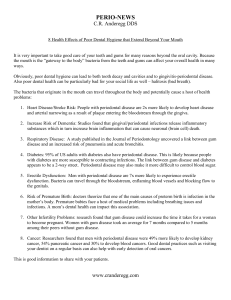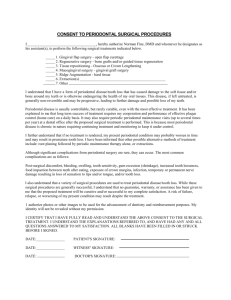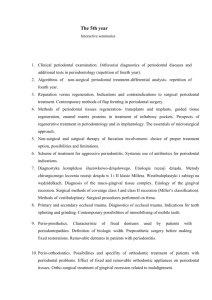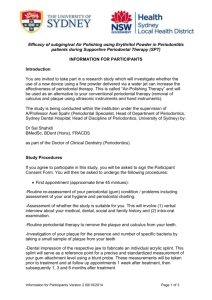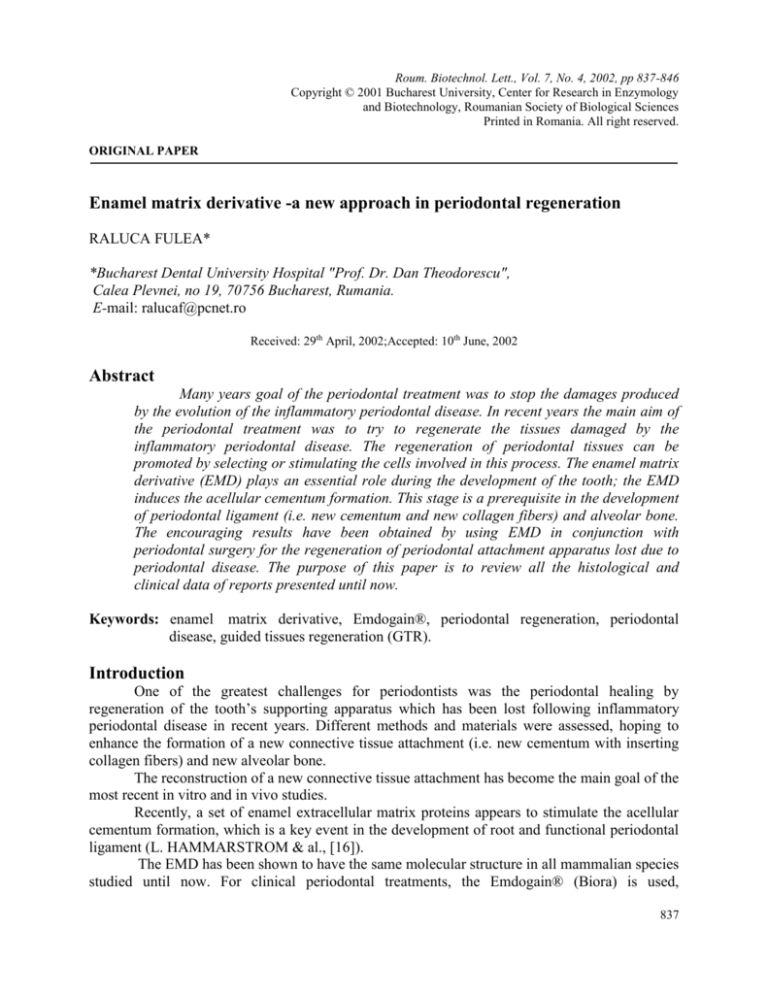
Roum. Biotechnol. Lett., Vol. 7, No. 4, 2002, pp 837-846
Copyright © 2001 Bucharest University, Center for Research in Enzymology
and Biotechnology, Roumanian Society of Biological Sciences
Printed in Romania. All right reserved.
ORIGINAL PAPER
Enamel matrix derivative -a new approach in periodontal regeneration
RALUCA FULEA*
*Bucharest Dental University Hospital "Prof. Dr. Dan Theodorescu",
Calea Plevnei, no 19, 70756 Bucharest, Rumania.
E-mail: ralucaf@pcnet.ro
Received: 29th April, 2002;Accepted: 10th June, 2002
Abstract
Many years goal of the periodontal treatment was to stop the damages produced
by the evolution of the inflammatory periodontal disease. In recent years the main aim of
the periodontal treatment was to try to regenerate the tissues damaged by the
inflammatory periodontal disease. The regeneration of periodontal tissues can be
promoted by selecting or stimulating the cells involved in this process. The enamel matrix
derivative (EMD) plays an essential role during the development of the tooth; the EMD
induces the acellular cementum formation. This stage is a prerequisite in the development
of periodontal ligament (i.e. new cementum and new collagen fibers) and alveolar bone.
The encouraging results have been obtained by using EMD in conjunction with
periodontal surgery for the regeneration of periodontal attachment apparatus lost due to
periodontal disease. The purpose of this paper is to review all the histological and
clinical data of reports presented until now.
Keywords: enamel matrix derivative, Emdogain®, periodontal regeneration, periodontal
disease, guided tissues regeneration (GTR).
Introduction
One of the greatest challenges for periodontists was the periodontal healing by
regeneration of the tooth’s supporting apparatus which has been lost following inflammatory
periodontal disease in recent years. Different methods and materials were assessed, hoping to
enhance the formation of a new connective tissue attachment (i.e. new cementum with inserting
collagen fibers) and new alveolar bone.
The reconstruction of a new connective tissue attachment has become the main goal of the
most recent in vitro and in vivo studies.
Recently, a set of enamel extracellular matrix proteins appears to stimulate the acellular
cementum formation, which is a key event in the development of root and functional periodontal
ligament (L. HAMMARSTROM & al., [16]).
The EMD has been shown to have the same molecular structure in all mammalian species
studied until now. For clinical periodontal treatments, the Emdogain® (Biora) is used,
837
RALUCA FULEA
representing the commercial name for the EMD. The Emdogain® is a gel made by the
combination of the EMD and the propylene glycol alginate (PGA) used as a vehicle. The EMD is
from around developing teeth in carefully selected young pigs, followed by special processing
procedures.
Properties of enamel matrix derivative. Histological and clinical findings
Regeneration of periodontal tissues
Histological data
By definition periodontal regeneration is the type of healing following surgical
periodontal treatment which results in the formation of a new connective tissue attachment (i.e.
new cementum with inserting collagen fibers) and of a new alveolar bone (T. KARRING & al,
[21]).
The periodontal regeneration is a complex biological process that proceeds in a
subsequent sequence and needs the participation of all the periodontal structures. In the sequence
of events resulting in either bone or cementum formation, periodontal ligament and bone can be
stimulated at various points. Classic receptor-mediated peptides or extracellular matrix molecules
for soft and hard tissues appear to allow stimulation of tissue formation cascade (D.L.
COCHRAN & J.M. WOZNEY [7]). The first level of the periodontal regeneration is an
interactive molecular and cellular level. The cellular events stimulate a number of subsequent
cellular events (such as chemotaxis, proliferation, differentiation and angiogenesis) which lead to
further progression of tissue formation (P.M. BARTOLD & A.S. NARAYANAN, [2]).
So, the sequences of the progression of the physiological periodontal regenerative process
are known as well as the order of their linkage: the initial inflammatory reaction, then the
appearance of proliferative tissue, the formation and the transformation of the conjunctive tissue.
The differentiation of the mesenchymal cells is very important; the fibroblastic cells guide the
conjunctive tissue formation, the osteoblastic cells are involved in the alveolar bone formation
and the cementum is promoted by the cementoblastic cells (S. PITARU & al., [27]). Periodontal
wound healing and regeneration require new matrix to be synthesized, creating an environment
into which cells can migrate. The EMD has the potential to significantly modulate matrix
synthesis (H.R. HAASE & P.M. BARTOLD, [13]), and can regulate dental follicle cells activity,
which, when appropriately triggered, have the ability to differenciate between periodontal
ligament fibroblasts, cementoblasts and osteoblasts (Y. TOKIYASU & al., [38]; Z. SCHWARTZ
& al. [30]; S.S. HAKKI & al. [14]).
Cultured human periodontal ligament cells exposed to EMD increase attachment rate,
growth rate and metabolism, and subsequently release several growth factors (transforming
growth factor beta 1, interleukin 6 and platelet derived growth factor) into the medium. Thus
EMD is able to regulate cell activities at a periodontal regeneration site in a process mimicking
natural root development (S.P. LYNGSTADAAS&al., [23]).
The major prerequisite for the periodontal regeneration is the formation of a new
cementum capable to provide a support for the new developed collagen fibers. The cementum
that is responsible for the insertion of the Sharpey's fibers is the acellular cementum.
The proteins that are involved in the formation of the acellular cementum are produced by
the Hertwig's sheath. The EMD is in a percentage of 90 a protein, more specifically amelogenin.
The secretion of the EMD is a prerequisite for the development of the periodontal ligament and
838
Roum. Biotechnol. Lett., Vol. 7, No. 4, 837-846 (2002)
Enamel matrix derivative -a new approach in periodontal regeneration
alveolar bone. The studies made with Emdogain® are based upon this physiological stage and
copy the original process of the periodontal development.
In vitro and in vivo studies showed that the porcine fetal enamel matrix proteins enhance,
in both animals and humans, the formation of a new layer of acellular cementum with inserting
perpendicularly collagen fibers and the formation of a new alveolar bone (L. HAMMARSTROM,
[15], L. HAMMARSTROM &. al., [16]). The regeneration of periodontal tissue is promoted by
the interaction of the amelogenins with the periodontal ligament cells when detached root surface
is conditioned with EMD (A.M. HOANG &al.,[19], A. SCULEAN & al., [31], R.A. YUKNA &
J.T. MELLONIG, [39]).
Clinical data
Clinical results of one and two years follow-up studies revealed that the treatments with
EMD are promising in the treatment of the advanced intrabony periodontal defects (one, two and
three-walled defects) at those patients without any local or systemic health problems which could
negatively affect the outcome of the therapy. In these advanced intrabony periodontal defects and
even in a circumferential defect the placement of Emdogain® results in a significant probing
attachment level gain, probing depth reduction and bone fill was evident on clinical probing and
during reentry procedure (G. RASPERINI & al., [28]; G. HEDEN, [18]; J.M. GLISE & al., [12]).
The stability of the obtained clinical results can be assured by a high level of oral hygiene (A.
SCULEAN & al., [31]). The surgical protocol is: 1. removal of local etiologic factors; 2. flap
design to maintain papilla architecture; 3. meticulous defect debridement and root planing; 4. root
treatment with 24% EDTA (ethylenediaminetetraacetic acid) for 2 minutes; 5. sutures placed
prior to Emdogain® application; 6. postoperative treatment with 0,12% chlorhexidine(G.
RASPERINI & al., [28]).
Inhibition of the epithelial growth
The EMD has also another very important feature, namely, its potential to inhibit or at
least to retard the epithelial down-growth. EMD acts as a cytostatic agent on epithelial cells and
the application of EMD suppresses the down-growth of junctional epithelium onto dental root, a
process that frequently interferes with the formation of new connective tissue attachments
(S.GESTRELIUS & al., [11]; T. KAWASE & al, [22]; S.P. LYNGSTADAAS&al., [23]). Thus a
proper and hermetical healing after the surgical procedure is provided and conditions for a true
periodontal regeneration are ensured.
Antibacterial effect
A common clinical observation following surgical periodontal therapy with EMD
(Emdogain®) is the improved healing of the soft tissues during the first post-operative period
(A.SCULEAN & al., [31]). Emdogain® might have an antibacterial effect on the vitality of the
ex vivo supragingival dental plaque flora due to the low pH (around 5.0) of the vehicle propylene
glycol alginate (PGA) and to the hydrophobic properties of EMD (A. SCULEAN & al., [35]).
Osteoactivity
Recent histological findings in mice (B.D. BOYAN& al, [4]) indicate that the EMD is
neither osteoconductive (see terminology), nor osteoinductive, but in association with a
biomaterial osteoinductive [i.e. demineralized freeze dried human bone allografts (DFDBA) with
Roum. Biotechnol. Lett., Vol. 7, No. 4, 837-846 (2002)
839
RALUCA FULEA
recombinant human bone morphogenetic protein-2 (rhBMP-2)] becomes osteoconductive.
Further clinical studies are needed before these results are confirmed.
Clinical safety
In spite of their animal origin the enamel matrix proteins have an extremely low
immunological potential. The absence of immunological reactions is shown by the normal levels
of IgG, IgE, IgA (O. ZETTERSTROM & al [40]). A more recent study confirms these results. In
2000 Heard & al.,( R.H. HEARD & al.,[17]) evaluate the effect of the repeated application of
enamel matrix derivative. Can this affect the healing of intraosseous defects by stimulating an
immune reaction to a foreign substance? The conclusion of the study is that the EMD is safe for
the treatment of intraosseous defects, even when used repeatedly and provide beneficial results.
Comparison between the EMD treatment and other surgical periodontal
treatments
Guided tissues regeneration (GTR.)
One of the most documented and predictible regenerative treatments is currently the
guided tissue regeneration (GTR). GTR depends on the exclusion of the gingival tissue from the
root surface during the first few months after the surgery. GTR implies the placement of a
mechanical barrier (non-bioabsorbable and bioabsorbable membranes) over the denuded root
surfaces and the periodontal defects, thus allowing cells originating from the periodontal ligament
and the alveolar bone to selectively repopulate the isolated space (S. NYMAN & al.,[25]; T.
KARRING & al., [21]). The premature exposure (before 3 months) of the membrane means that
bacteria may infiltrate the membrane and compromise the results. The histological and clinical
results of studies made with both type of membranes (non-bioabsorbable and bioabsorbable) are
similar ( P. BOUCHARD & al., [3], R.G. CAFFESSE & al., [5]).
The EMD approach seems to require a simpler surgical procedure, an easier manipulation
than GTR. There is not any risk to exposure and no anatomical limitations as in case of GTR (S.
AROCA & al., [1]). It is important to note that the use of EMD in contradistinction to achieving
regeneration with GTR in smaller defects, does not require space maintenance. In 2000 Sculean
& al., evaluate from a histological point of view, in monkeys, the effect of treating recession-type
defects with EMD, GTR, a combination between EMD and GTR and with a coronally
repositioned flap (control sites). In the control specimens the healing was characterized by a long
junctional epithelium and limited new connective tissue attachment and bone formation. The
defects treated only with EMD presented new attachment formation to a various extent whereas
the GTR treated sites consistently presented a new attachment together with new bone, when the
membranes were not exposed. The observation that the outcome was also negatively affected by
membrane exposure when GTR was supplemented with EMD indicates that this complication
may not be overcome with the application of a biologically active substance such as EMD. The
regenerated cementum after treatment with EMD alone or a combination of EMD and GTR was
predominantly of an acellular type, whereas GTR alone resulted in a mixt acellular and cellular
type. These findings support the previous observations on animals, which indicate that the EMD
might selectively enhance acellular cementum formation (A. SCULEAN & al., [32], [33],). The
combined therapy did not produce any additional improvement. These findings are similar in
humans (A. SCULEAN & al., [36]). However, these results do not corroborate with the findings
from other previous studies where it was demonstrated that the healing in mandibular degree III
Roum. Biotechnol. Lett., Vol. 7, No. 4, 837-846 (2002)
840
Enamel matrix derivative -a new approach in periodontal regeneration
furcation defects following the combined EMD and GTR treatment, enhance a higher level of
periodontal regeneration compared with GTR therapy alone (N. DONOS & al., [9]).
Debridement flap.
All reports are in agreement that the treatment with EMD is clinically superior to the
treatment without EMD (the open flap debridement) in any parameter evaluated, including the
probing attachment level gain, probing depth reduction and bone fill (M. SILVESTRI & al.,[37];
A. SCULEAN & al.,[32] , S.J. FROUM & al., [10]). Reentry data demonstrate that the
percentage of fill of osseous defects treated with EMD can be compared favorably with the
treatment results utilizing bone grafts or membrane barriers.
EMD combined with bone derived xenograft.
However, one of the inconvenients of the EMD treatment is that the amount of
regenerated tissues is dependent upon the available space under the mucoperiosteal flap. Thus,
from a clinical point of view, the treatment of advanced, large and deep intrabony defects with
EMD may be impeded by an eventual collapse of the mucoperiosteal flap. As a consequence, a
reduced space for periodontal regeneration occurs (A. SCULEAN & al., [32]).
In 2000 Sculean et al, treated 12 advanced intrabony defects with the combination of
EMD and bovine derived xenograft (BDX) trying to prevent the collapse of the mucoperiosteal
flap and to ensure optimal wound stability. This combination would provied the best results
because the bone graft (Bio-Oss®) would preserve the space for the regeneration process,
preventing the collapse of the flap and the EMD would inhibit the epithelial down-growth (A.
SCULEAN & al., [34]). BDX shows an excellent osteoconductivity, is very well integrated into
bone tissue and is slowly resorbed by osteoclastic activity (C. CHEN & al., [6]).Since the organic
components are removed, the graft does not elicit any allergic reactions and is tolerated clinically
very well (C.R. RICHARDSON & al., [29]). It is, however, important to point out that the
presented clinical results need to be supported by further histological evidence.
Risk factors which may impede the EMD treatments
The risk factors are generally those of the periodontal disease. They are local and
systemic. Local risk factors are: any areas that harbor bacteria (restorations with overhangs,
orthodontic appliances, etc), the parafunctional habits such as bruxing, the degree of the oral
hygiene (in general, the better the personal plaque control, the better the long-term outlook for the
dentition) and the patient's compliance to the suggested maintenance following regenerative
procedures (in general, the better the compliance, the fewer teeth will be lost). Systemic risk
factors are: smoking, diabetes and the genotype status for the Interleukin-1(IL-1) gene-the
genotype PST® .The study of McGuire et Nunn, 1999 shows that the genotype PST® is positive
in 32% of advanced periodontitis and 30% for the group with the prognosis during 12 years. The
risk is more than double when a PST positive patient is also smoking (M. MCGUIRE & E.
NUNN, [24]). But the significance is still controversially discussed in the literature. The most
recent study (P.N. PAPAPANOU & al.,[26]) indicates that only the notion of susceptibility can
be advanced for the genotype PST®.
Roum. Biotechnol. Lett., Vol. 7, No. 4, 837-846 (2002)
841
RALUCA FULEA
Conclusions
EMD has been successfully employed to mimic natural cementogenesis, to restore fully
functional periodontal ligament, cementum and alveolar bone in patients with moderate to severe
periodontitis. When applied to denuded root surfaces EMD forms a matrix that locally facilitates
true regenerative response in the adjacent tissue. However, the mechanism by which EMD may
enhance cementogenesis is still poorly investigated and remains to be elucidated. Further
histological studies using higher numbers of animals and defects are needed in order to clarify the
role of enamel matrix protein derivative on periodontal wound healing and regeneration.
Also the long term clinical studies are necessary to confirm these excellent results,
because until now the studies made are for a short period of time (one or two years follow-up).
Some inconvenients of the EMD which may impeded the out come of the regenerative treatment
are also needed to be solve. The EMD is not able to attach to the root surface for a period longer
than two weeks, which in some types of defects may be a too short time for optimal healing (S.
GESTRELIUS & al., [11]).
In addition, if the available data are confirmed, the utility of the enamel matrix proteins
may be expanded for other types of periodontal therapy. A recent study in beagle dogs shows the
utility of EMD in periodontal healing after teeth replantation in a much lower incidence of
ankylosis and a higher incidence of healed periodontal ligament in the Emdogain® group
compared with the controls (M.K. IQBAL & M. BAMMAAS, [20]). Maybe in the future the
implant approach and its complications (the periimplantitis which are threatening the durability
of the implants) will be solved or at least much improved with the periodontal regeneration
enhanced by EMD treatment.
However, EMD provides an excellent alternative to current methods of periodontal
treatments and allows to the clinician to achieve a true periodontal regeneration.
Terminology
Regeneration is the reproduction or reconstruction of a lost or injuried part. The regeneration in
periodontology is the formation of new connective tissue attachment (i.e. new cementum with
inserting collagen fibers) and new alveolar bone following surgical periodontal treatment (T.
KARRING & al., [21]).
Repair can be defined as the healing of a wounded tissue that does not fully restore its previous
architecture or function. The healing by repair in the case of the periodontium does not result in
restoration of the original form (a new created cementum, periodontal ligament and alveolar
bone), nor in the original function of the periodontal attachment apparatus restored.
Osteogenesis represents all the steps and processes leading to bone formation.
Osteoinductivity is the capacity of a biomaterial to induce the differentiation of host
mesenchymal cells located near the graft into osteoprogenitor cells. A biomaterial is considered
osteoinductive when bone formation occurs after its implantation in a non osseous environment.
Osteoactivity exhibits various forms and includes osteogenicity, osteoinductivity and
osteoconductivity (C.J. DAMIEN & J.R. PARSONS,[8]).
Osteoconductivity is the property of a biomaterial to allow ingrowth of vessels as well as
osteoprogenitor cells from the recipient bed into the graft. So the graft is acting like a scaffold.
842
Roum. Biotechnol. Lett., Vol. 7, No. 4, 837-846 (2002)
Enamel matrix derivative -a new approach in periodontal regeneration
References
1. S. AROCA, B. BARBIERI, D. ETIENNE. Tissue regeneration induced by enamel matrix
protein derivate: a comparison with guided tissue regeneration. J. Parodont. Implant.
Orale, 18, (4) 401-409 (1999).
2. P.M. BARTOLD, A.S. NARAYANAN. Biology of the periodontal connective tissues.
Chicago: Quintessence, 1998, pp.173-195.
3. P. BOUCHARD, J.L. GIOVANNOLI, C. MATTOUT, M. DAVARPANAH, D.
ETIENNE.Clinical evaluation of a bioabsorbable regenerative material in mandibular
class II furcation therapy. J. Clin. Periodontol., 24, 511-518 (1997).
4. B.D. BOYAN, T.C. WEESNER, C.H. LOHMANN, D. ANDREACCHIO, D.L.
CARNES, D.D. DEAN, D.L. COCHRAN, Z. SCHWARTZ. Les derives de la matrice
amellaire ameliorent la formation osseuse induite par allogreffe d'os lyophilise
demineralise: etude in vivo. J. Periodontol., 71(8), 1278-1286 (2000).
5. R.G. CAFFESSE, L.F. MOTA, C.R. QUINONES, E.C. MORRISON. Clinical
comparison of resorbable and non resorbable barriers for guided periodontal tissue
regeneration. J Clin Periodontol, 24, 747-752 (1997).
6. C. CHEN, H. WANG, F. SMITH, G. GLICKMAN, Y. SHYR, R. O'NEAL. Evaluation of
a collagen membrane with and without bone grafts in treating periodontal infrabony
defects. J. Periodontol., 66, 838-847 (1995).
7. D.L. COCHRAN, J.M. WOZNEY. Biological mediators for periodontal regeneration.
Periodontol. 2000, 19, 40-58 (1999).
8. C.J. DAMIEN, J.R. PARSONS. Bone graft and bone substitutes: a review of current
technology applications. J. Appl. Biomater., 2, 187-208 (1991).
9. N. DONOS, A. SCULEAN, L. GLAVIND, E. REICH, T. KARRING. Treatment of
mandibular degree III furcation involvements with a bioresorbable membrane and
Emdogain® in monkeys. J. Dent. Res. (Spec. Issue) , 77,:924 (1998).
10. S.J. FROUM, M.A. WEINBERG, E. ROSENBERG, D. TARNOW. A comparative study
utilizing open flap debridement with or without enamel matrix derivative in the treatment
of periodontal intrabony defects a 12 months re-entry study. J. Periodontol., 72(1), 25-34
(2001).
11. S. GESTRELIUS, C. ANDERSSON, A.C. JOHANSSON, E. PERSSON, E. BRODIN, A.
BRODIN et al. Formulation of enamel matrix derivative for surface coating. Kinetics and
cell colonization. J. Clin. Periodontol., 24, 678-684 (1997).
12. J.M. GLISE, V. MONNET-CORTI, A. BORGHETTI. Traitement des lesions
intraosseuses a l'aide de proteines derivees de la matrice amelaire.Rapports de 35 sites a 1
an. J. Parodont. Implant. Orale, 20, 247-253 (2000).
Roum. Biotechnol. Lett., Vol. 7, No. 4, 837-846 (2002)
843
RALUCA FULEA
13. H.R. HAASE, P.M. BARTOLD. Enamel matrix derivative induces matrix synthesis by
cultured human periodontal fibroblast cells. J. Periodontol., 72(3), 341-348 (2001).
14. S.S. HAKKI, J.E. BERY, M.J. SOMERMAN. The effect of enamel matrix protein
derivative on follicle cells in vitro. J. Periodontol., 72(5), 679-87 (2001).
15. L. HAMMARSTROM. Enamel Matrix, cementum development and regeneration. J. Clin.
Periodontol., 24, 658-668 (1997).
16. L. HAMMARSTROM, L. HEIJL, S. GESTRELIUS. Periodontal regeneration in a buccal
dehiscence model in monkeys after application of enamel matrix proteins. J. Clin.
Periodontol., 24, 669-677 (1997).
17. R.H. HEARD, J.T. MELLONIG, M.A. BRUNSVOLD, D.J. LASHO, R.M. MEFFERT,
D.L. COCHRAN. Clinical evaluation of wound healing following multipleexposures to
enamel matrix protein derivative in the treatment of intrabony periodontal defects. J.
Periodontol., 71(11), 1715-1721 (2000).
18. G. HEDEN. Etude de 72 defauts intra-osseux traites avec Emdogain; resultats cliniques et
radiographiques apres 1 an. Parodont. Dent. Rest., 20, 127-139 (2000).
19. A.M. HOANG, T.W. OATES, D.L. COCHRAN. In vitro wound healing responses to
enamel matrix derivative. J. Periodontol., 71, 1270-1278 (2000).
20. M.K. IQBAL, N. BAMAAS. Effect of enamel matrix derivative (Emdogain® upon
periodontal healing after replantation of permanent incisors in beagle dogs. Dent.
Traumatol., 17(1), 36-45 (2001).
21. T. KARRING, S. NYMAN, J. GOTTLOW, L. LAURELL. Development of the
biological concept of guided tissue regeneration-animal and human studies. Periodontol.
2000, 1, 26-35 (1993).
22. T. KAWASE, K. OKUDA, H. YOSHIE, D.M. BURNS. Cytostatic action of
enamelmatrix derivative (Emdogain®) on human oral squamous cell carcinoma-derived
SCC25 epithelial cells. J. Periodontal. Res., 35(5), 291-300 (2000).
23. S.P. LYNGSTADAAS, E. LUNDBERG, H. EKDAHL, C. ANDERSSON, S.
GESTRELIUS. Autocrine growth factors in human periodontal ligament cells cultured on
enamel matrix derivative. J. Clin. Periodontol., 28(2), 181-188 (2001)
24. M. MCGUIRE, E. NUNN. Prognosis versus actual outcome in the effectiveness of
clinical parameters and IL-1, genotype in accur tely predicting prognoses and tooth
survival. J. Periodontol., 70, 49-56 (1999).
25. S. NYMAN, J. LINDHE, T. KARRING, H. RYLANDER. New attachment following
surgical treatment of human periodontal disease. J. Clin. Periodontol., 9, 290-296 (1982).
26. P.N. PAPAPANOU, A.M. NEIDERUD, J. SANDROS, G. DAHLEN. Polymorphisme du
gene interleukine-1 (IL-1) et etat parodontal. Etude cas-controle. J. Clin. Periodontol., 28,
384-396 (2001).
844
Roum. Biotechnol. Lett., Vol. 7, No. 4, 837-846 (2002)
Enamel matrix derivative -a new approach in periodontal regeneration
27. S. PITARU, C.A.G. MC CULLOCH, A.S. NARAYANAN. Cellular origins and
differentiation control mechanisms during periodontal development and would healing. J.
Periodontol. Res., 29, 81-94 (1994).
28. G. RASPERINI, G. RICCI, M. SILVESTRI. Surgical technique for treatment of
intrabony defects with enamel matrix derivative (Emdogain®): 3 case reports. Int.
Restorative J. Periodontics Dent., 19(6), 578-587 (1999).
29. C.R. RICHARDSON, J.T. MELLONIG, M.A. BRUNSVOLD, L MCDONNELL, DL
COCHRAN. Clinical evaluation of Bio-Oss®: a bovine-derived xenograft for the
treatment of periodontal osseous defects in humans.J. Clin. Periodontol., 26, 421-428
(1999).
30. Z. SCHWARTZ, D.L. Jr CARNES, R. PULLIAM, C.H. LOHMANN, V.L. SYLVIA, Y.
LIU, D.D. DEAN, D.L. COCHRAN, B.D. BOYAN. Porcine fetal enamel matrix
derivative stimulates proliferation but not differentiation of pre-osteoblastic 2T9 cells,
inhibits proliferation and stimulates differentiation of osteoblast-like MG63 cells, and
increases proliferation and differentiation of normal human osteoblast NHOst cells. J.
Periodontol., 71(8), 1287-96 (2000).
31. A. SCULEAN, G.C. CHIANTELLA, N. DONOS, A. BLAES, A.E. SCULEAN, M.
BRECX. Treatment of advanced intrabony defects with an enamel matrix protein
derivative.A pilot study in one monkey and a two year report of twenty human cases. J.
Parodont. Implant. Orale, 18 (4), 377-391 (1999).
32. A. SCULEAN, N. DONOS, E. REICH, M. BRECX, T. KARRING. Healing of recessiontype defects following treatment with enamel matrix proteins or guided tissue
regeneration. A pilot study in monkeys. J. Parodont. Implant. Orale, 19(1), 19-33 (2000).
33. A. SCULEAN, N. DONOS, E. REICH, M. BRECX, T. KARRING. Treatment of
intrabony defects with guided tissue regeneration and enamel matrix proteins. An
experimental study in monkeys. J. Clin. Periodontol., 27, 466-472 (2000).
34. A. SCULEAN, M. BRECX, E. REICH, G.C. CHIANTELLA. Treatment of advanced
intrabony defects with enamel matrix proteins (Emdogain) combined with a bovinederived xenograft (Bio-Oss). J. Parodont. Implant. Orale, 19(4), 397-411 (2000).
35. A. SCULEAN, T.M. AUSCHILL, N. DONOS, M. BREX, N.B. ARWEILER. Effect of
an enamel matrix protein derivative (Emdogain®) on ex vivo dental plaque vitality. J.
Clin. Periodontol., 28:1074-1078 (2001).
36. A. SCULEAN, P. WINDISCH, G.C. CHIANTELLA, N. DONOS, M. BRECX, E.
REICH. Treatment of intrabony defects with enamel matrix proteins and guided tissue
regeneration. A prospective controlled clinical study. J. Clin. Periodontol., 28, 397-403
(2001).
Roum. Biotechnol. Lett., Vol. 7, No. 4, 837-846 (2002)
845
RALUCA FULEA
37. M. SILVESTRI, G. RASPERINI, S. SARTORI, V. CATTANEO. Comparison between
the treatment of intrabony periodontal defects with enamel matrix proteins, with guided
tissue regeneration(GTR) by non resorbable memebrane and with Widman flap:pilot
study. J. Clin. Periodontol., 27(8), 603-610 (2000).
38. Y. TOKIYASU, T. TAKATA, E. SAYGIN, M. SOMERMAN. Enamel factors regulate
expression of genes associated with cementoblasts. J. Periodontol., 71(12), 1829-39
(2000).
39. R.A. YUKNA, J.T. MELLONIG. Histologic evaluation of periodontal healing in humans
following regenerative therapy with enamel matrix derivative.A 10-case series. J.
Periodontol., 71(5), 752-9 (2000).
40. O. ZETTERSTROM, C. ANDERSSON, L. ERIKSSON, J.H. FREDERIKSSON, G.
HEDEN et al. Clinical safety of enamel matrix derivate (Emdogain®) in the treatment of
periodontal defects. J. Clin. Periodontol., 24, 697-704 (1997).
846
Roum. Biotechnol. Lett., Vol. 7, No. 4, 837-846 (2002)






